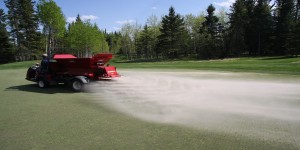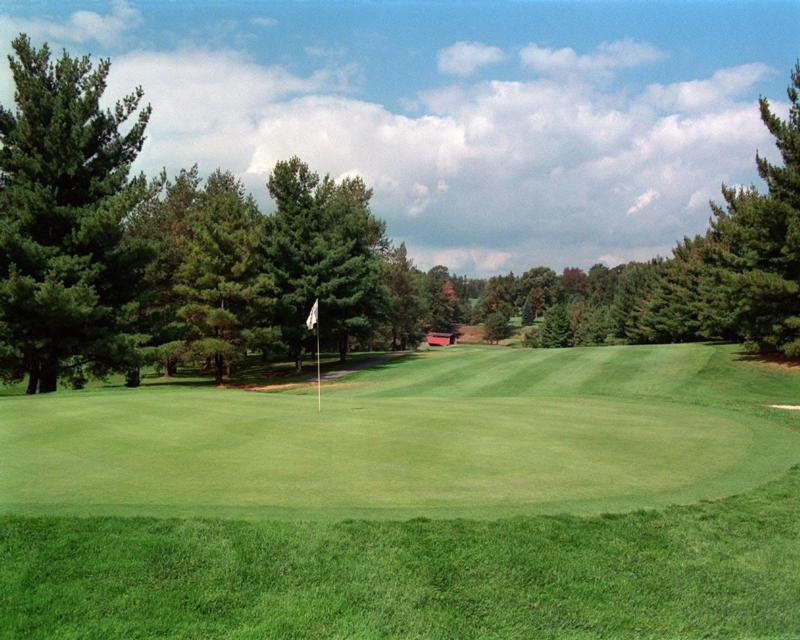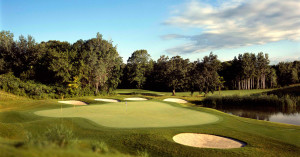Maintaining or even improving the rate water moves into soils is an important part of aeration. The procedure creates channels in the upper portion of the soil profile that allow water to percolate or move into the soil profile more rapidly. As the term aeration implies, the practice also increases the amount of space avail-able for oxygen (air) to penetrate thesoil, which is critical for root growth and, ultimately, plant growth. Improve-ment in oxygen levels and water infiltration are achieved through the removal of organic matter. In modern putting green maintenance, removal of organic matter (or thatch) from the upper portion of the soil profile and replacement with new sand topdressing to modify the existing soil may be the most critical reasons to aerate greens. The grass is constantly producing organic matter through normal growth processes. Thatch is like a sponge, holding many times its weight in water. As organic matter increases, more water is held in the upper portion of the soil profile. While a limited amount of thatch is necessary, when organic matter levels increase to 3 to 4%, potential turfgrass problems, such as diseases and mower scalping, increase dramatically, especially under hot and wet conditions. To prevent excessive organic matter accumulation, research sug-gests that 15 to 20% of the surface area of a putting green needs to be impacted via some method of soil/thatch removal. This can be done through core aeration or aggressive, deep verticutting. Regardless of the method selected, filling the holes or grooves with sand is essential. The sand on the surface may be annoying at times, but it is an important part of maximizing the benefit of core aeration. Core aeration and topdressing are important parts of putting green maintenance, especially when golfer expectations for course conditioning are considered.
MINIMIZING HEALING TIME
Speaking of filling aeration holes with sand, topdressing is an important component for healing and playability. Golfers do not despise aeration; they rue the resulting 10 to 14+ days of reduced playability. If putting quality was disrupted only for a day or two, the process would not be so reviled. Thus, superintendents have a responsibility to ensure that all available programs are being implemented to restore play-ability as quickly as possible. Filling aeration holes completely with sand is an important start to this process. The greens will be smoother and their appearance will be better than partially filled or open holes. Completely filling the holes with sand also maximizes the agronomic benefit of core aeration. Excessive dragging of sand can result in severe mechanical damage in some instances, although not as often during cool weather. A slight increase in nitrogen fertility to stimulate growth should be made immediately prior to aeration. Applying ¼ to ½ lb. of actual nitrogen per 1,000
square feet from a readily available granular nitrogen source is one way to stimulate growth to decrease the time required for the aeration holes to close. Some superintendents apply liquid fertilizers through the sprayer on a tighter-than-normal interval to stimulate growth without causing an excessive flush. Application of around 1/8 lb. of nitrogen per 1,000 square feet every five to seven days is common. Keep in mind that soil temperatures are important to turf growth. If aeration is performed under cold conditions, turf growth and subsequent healing will be slow. The goal is to close aeration holes as quickly as possible, and it is important to implement strategies to increase turf growth rate when weather conditions allow. It was mentioned that missing spring aeration is not necessarily an agronomic catastrophe, but it is impor-tant to note that by skipping aeration, it only means inevitable maintenance is deferred. The need for aeration increases with each skipped mainte-nance practice. The problem is, aeration programs go hand in hand with the season-long golfer expectations for playability. Firm, well-paced greens are consistently expected. Diluting organic matter with sand through core aeration, deep verticutting, and light top dressing programs directly impacts a golf course superintendent’s ability to provide expected conditions. Greens with greater quantities of sand to dilute thatch in the upper portion of the soil profile are generally firmer, drain more quickly after rainfall, and provide better playability. Firm greens are less susceptible to scalping and othermechanical damage. So, while you may not have a catastrophe, this does not mean that skipping aeration does not have negative consequences. The bottom line is, aeration is performed for the health of the grass and, ultimately, the playability of the putting greens. Greens with less organic matter, properly managed through aeration and other techniques, will be better greens on a season-long basis. Try not to getcaught up in the short-term disruption to playability, and focus on the long-term benefits that core aeration programs provide.
DARIN S. BEVARD is a senior agronomist in the Mid-Atlantic Region, where the occasional harsh winter creates great challenges with earl season maintenance operations.





